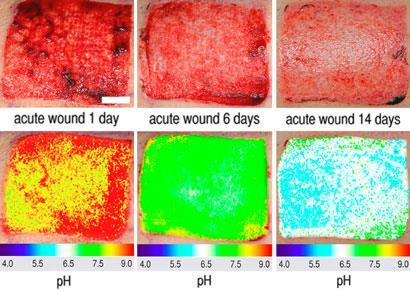2D imaging of pH in vivo shows promise for wound monitoring in medicine
Researchers in Germany have devised a safe method to image the pH of tissue in the human body. The method, which involves measuring the luminescence of microparticle-bound dyes, could help physicians monitor wound healing and tumour growth.
pH is crucial in several bodily processes. During wound healing, disturbed layers of skin can affect the pH, which in turn affects the function of certain enzymes necessary for new tissue formation. With tumours, changes in pH are also a signal of changes in metabolism, or the onset of oxygen deficiency. Since pH can vary over a small area, physicians are keen to find ways to monitor the pH in the body in two dimensions.
The established medical approach to measuring pH uses a glass electrode, which monitors the potential difference created by adsorbed, acidic protons on the glass surface. But the glass electrode allows only for spot measurements of pH, and is therefore unsuited to 2D imaging. Although researchers have previously developed other methods to image pH in 2D, these have been slow, unreliable under different conditions, or biologically incompatible. ’Our approach is fast, easy, reliable under changing conditions, and suitable for in vivo use on live human subjects,’ says Stephan Schreml of University Hospital Regensburg.
The method Schreml and his colleagues developed involves using two luminescent dyes - one ’indicator’ dye and one ’reference’ dye - bound to microparticles and immobilised in a polyurethane hydrogel matrix to create the 2D sensors. Both dyes absorb the light from a light-emitting diode and re-emit it at a different wavelength, but the indicator dye re-emits for a shorter period. In addition, the light emission of the indicator dye is stymied by the absorption of acidic protons, so that a lower (more acidic) pH results in less light emission. Using a camera, Schreml’s group therefore measures the light emission of the indicator and reference dyes together, then later when just the reference dye is emitting, and takes the ratio to calculate the pH.

’It’s a very nice implementation of existing techniques to get a macroscopic reading of pH based on luminescence indicators,’ says James Demas, an expert in luminescence at the University of Virginia, US. ’One gets a continuous 2D readout of the pH from basically a single-shot measurement. This avoids the problems inherent in point detection methods, such as the pH electrode.’
Schreml says his group’s next task is to study the pH distribution of chronic wounds. ’We are also trying to simplify our method even more to make it easier to use in laboratory settings or in a clinical routine,’ he adds.
Jon Cartwright
References
et alProc. Natl. Acad. Sci. USA, 2011, DOI: 10.1073/pnas.1006945108






No comments yet